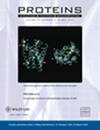铜(II)和保守的铜结合位点对多铜氧化酶 CopA 的影响以及 BioMnOx 的表征
IF 3.2
4区 生物学
Q2 BIOCHEMISTRY & MOLECULAR BIOLOGY
引用次数: 0
摘要
微生物除锰过程被认为是由锰氧化酶催化氧化锰(II)组成的。本研究纯化了多铜氧化酶 CopA,在体外表现出很高的锰氧化活性,并发现 Cu(II) 能显著增强其锰氧化活性。利用基因定点突变技术突变了 CopA 的四个保守的铜结合位点,得到了四个突变株。结果发现,H120 是 CopA 的催化活性位点。Cu(II)的缺失和保守的铜结合位点H120的突变导致乙氧基甲酰基和醌修饰的缺失、修饰数量的减少和修饰位置的改变,最终导致蛋白质活性从85.87%下降到70.1%。这些结果表明,Cu(II)和 H120 在多铜氧化酶 CopA 的锰氧化过程中起着不可或缺的作用。X 射线光电子能谱(XPS)分析表明,菌株和 CopA 产生的生物锰氧化物均由 MnO2 和 Mn3O4 组成,锰的平均价态为 3.2。本文章由计算机程序翻译,如有差异,请以英文原文为准。
Effect of Cu(II) and Conserved Copper Binding Sites on the Multicopper Oxidase CopA and Characterization of BioMnOx
The microbial manganese removal process is believed to consist of the catalytic oxidation of Mn(II) by manganese oxidase. In this study, the multicopper oxidase CopA was purified and exhibited high manganese oxidation activity in vitro, and it was found that Cu(II) can significantly enhance its manganese oxidation activity. Gene site‐directed mutagenesis was used to mutate four conserved copper binding sites of CopA to obtain four mutant strains. The manganese removal efficiencies of the four strains were determined, and it was found that H120 is the catalytically active site of CopA. The loss of Cu(II) and the mutation of the conserved copper binding site H120 resulted in the loss of ethoxyformyl and quinone modifications, a reduction in the number of modifications, and a change in the position of modifications, eventually causing a decrease in protein activity from 85.87% to 70.1%. These results reveal that Cu(II) and H120 play an indispensable role in manganese oxidation by the multicopper oxidase CopA. X‐ray photoelectron spectroscopy (XPS) analysis indicates that biogenic manganese oxides produced by strains and by CopA were both composed of MnO2 and Mn3 O4 and that the average valence of Mn was 3.2.
求助全文
通过发布文献求助,成功后即可免费获取论文全文。
去求助
来源期刊

Proteins-Structure Function and Bioinformatics
生物-生化与分子生物学
CiteScore
5.90
自引率
3.40%
发文量
172
审稿时长
3 months
期刊介绍:
PROTEINS : Structure, Function, and Bioinformatics publishes original reports of significant experimental and analytic research in all areas of protein research: structure, function, computation, genetics, and design. The journal encourages reports that present new experimental or computational approaches for interpreting and understanding data from biophysical chemistry, structural studies of proteins and macromolecular assemblies, alterations of protein structure and function engineered through techniques of molecular biology and genetics, functional analyses under physiologic conditions, as well as the interactions of proteins with receptors, nucleic acids, or other specific ligands or substrates. Research in protein and peptide biochemistry directed toward synthesizing or characterizing molecules that simulate aspects of the activity of proteins, or that act as inhibitors of protein function, is also within the scope of PROTEINS. In addition to full-length reports, short communications (usually not more than 4 printed pages) and prediction reports are welcome. Reviews are typically by invitation; authors are encouraged to submit proposed topics for consideration.
 求助内容:
求助内容: 应助结果提醒方式:
应助结果提醒方式:


